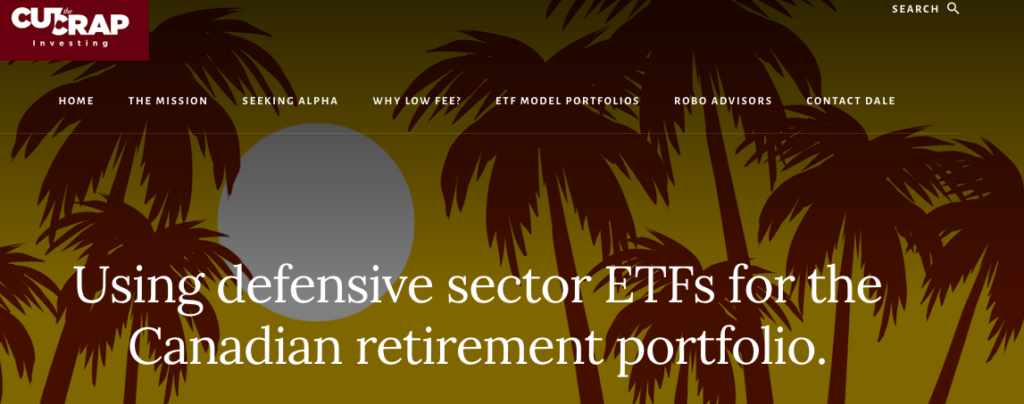By Dale Roberts
Special to Financial Independence Hub
In a recent post we saw that the defensive sectors were twice as effective as a balanced portfolio moving through and beyond the great financial crisis. The financial crisis was the bank-failure-inspired recession and market correction of 2008-2009 and beyond. It was the worst correction since the dot com crash of the early 2000’s. Defensive sectors can play the role of bonds (and work in concert with bonds) to provide greater financial stability. With defensive sector ETFs you might be able to build a superior Canadian retirement portfolio.
First off, here’s the original post on the defensive sectors for retirement.
The key defensive sectors are healthcare, consumer staples and utilities.
And a key chart from that post. The defensive sectors were twice as good as the traditional balanced portfolio. The chart represents a retirement funding scenario.

You can check out the original post for ideas for U.S. dollar defensive sector ETFs.
The following is for Canadian dollar accounts. Keep in mind, this is not advice. Consider this post as ‘ideas for consideration’ and part of the retirement portfolio educational process.
The yield is shown as an annual percentage as of mid March, 2023.
80% Equities / 20% Bonds and Cash
Growth sector ETFs
- 15% VDY 4.6% Canadian High Dividend
- 15% VGG 1.8% U.S. Dividend Growth
Canadian defensive sector ETFs
- 15% ZHU 0.5% U.S Healthcare
- 10% STPL 2.4% Global Consumer Staples
- 5.0% XST 0.6% Canadian Consumer Staples
- 10% ZUT 3.7% Canadian Utilities
Inflation fighters
- 5% PRA 3.0% Diversified Inflation Assets
- 5% XEG 3.4% Oil and Gas Stocks
Bonds and Cash
- 10% XSB 2.4% Short Term Bonds
- 10% Savings and GICs 3%-5%
On the savings front you will find savings account ETFs with yields near 5%.
You might also check out EQ Bank for savings and GICs. They offer registered accounts and U.S. dollar accounts.
A Canadian investor may use the US. sector ETFs in RRSP/RRIF and taxable accounts to create more optimal tax efficiency. They may avoid the withholding taxes on U.S. dividends. You’ll some info and links on the ETF model portfolio page.
Find your own comfort level
The above portfolio for consideration has 60% in defensive assets, the defensive stocks plus the bonds and cash. You may decide to go more defensive with greater cash and bonds. Given the times, I would not argue with a retiree that would want to completely remove sequence of returns risk in the first 5 years of retirement. That is, you would have those years covered by cash (GICs) and bonds.
You would essentially retire “risk free” for that time period. Should inflation continue to bite, you have the inflation-fighting basket that should provide a buffer. Your defensive stocks may once again perform better than bonds (as a stock market shock absorber). You also have portfolio income (dividends) from the stock assets.
Today, we see so many retirees struggling with the emotional impact of falling markets and robust inflation. It is difficult to sell stock assets to fund retirement as they decline. And truly, we have not yet had a material correction in a balanced stock portfolio, or balanced portfolio that includes bonds. Things may get more challenging if we do enter a recession (that most economists and portfolio managers say is more than likely).
The 7-ETF portfolio for retirees
Keep in mind there is nothing wrong with the 7-ETF portfolio for retirees. As suggested in the post, I would shade in some dedicated inflation fighters.
I prefer to use more defensive sector equity allocation. That is a personal choice based on my own research. And I certainly like the all-weather portfolio approach for retirement.
We are not feeling the crunch of inflation.
The retirement plan
Just as important as the investment assets and allocation is the greater financial plan. Self-directed investors can access an advice-only retirement planner. You’ll receive conflict-free advice that is not attached to any financial assets.
The self-directed investor might consider the service provided by Mark Seed from My Own Advisor. He runs Cashflows & Portfolios, where they will provide options for that optimal retirement funding strategy. That service is provided for a very reasonable fee.
If you do head to Cashflow & Portfolios (as do many Cut The Crap Investing readers), be sure to tell them Cut The Crap Investing sent ya.
For advice and planning and low fee portfolios, Justwealth is also a popular choice.
 Dale Roberts is the owner operator of the Cut The Crap Investing blog, and a columnist for MoneySense. This blog originally appeared on Cut the Crap Investing on March 18, 2023 and is republished on the Hub with permission.
Dale Roberts is the owner operator of the Cut The Crap Investing blog, and a columnist for MoneySense. This blog originally appeared on Cut the Crap Investing on March 18, 2023 and is republished on the Hub with permission.


